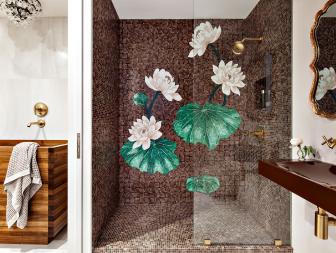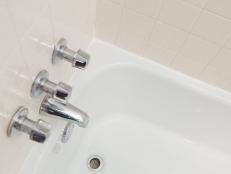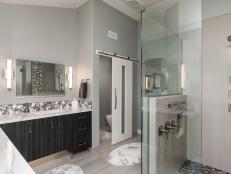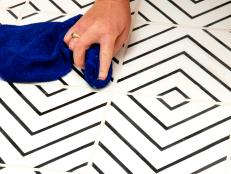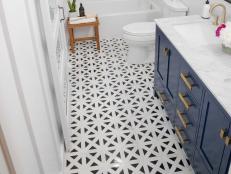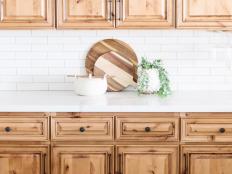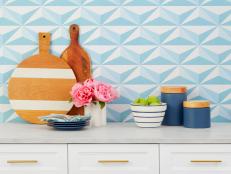How to Install Tile in a Bathroom Shower
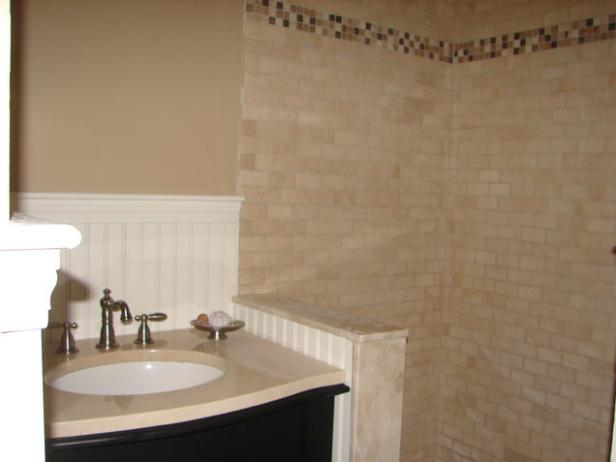
Materials and Tools:
marble tile
thin-set mortar
sanded grout
unsanded grout
fixtures
screws
wet saw
notched trowel
level
tape measure
electric screwdriver
spacers
pencil
sanding block
mask
rubber grout float
sponge
safety glasses
broom
buckets
tile nippers
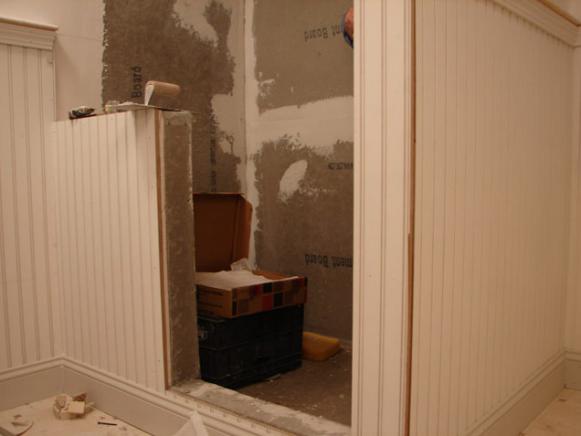
Steps:
1. Once demolition of the old tile is complete, install a cement backer board in the shower area.
Have a professional install a shower membrane and shower pan appropriate for the space. In our project, the shower pan is poured concrete.
Save time by setting several tiles at once. Before you start setting tile, take some measurements and see how the tiles will all lay out.
2. In our project, we used Crema Marfil, an Italian tumbled marble tile. The tiles come in different sizes, pre-spaced on mats. On the ceiling and floor of the shower, we used 2"x2" tiles and on shower walls, 2"x4" tiles.
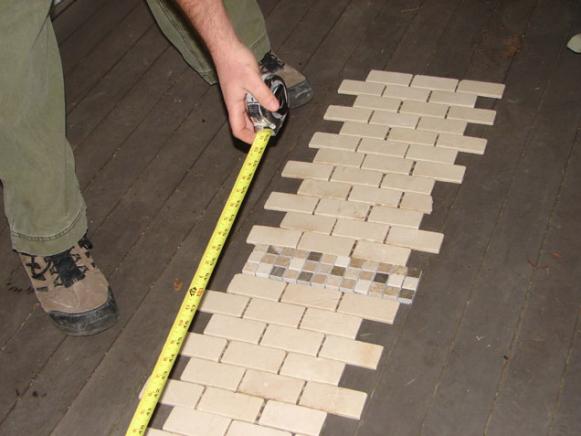
In our project, we set the tile for the wall opposite the shower door first. Measure the top and bottom of the shower wall (ours is 82" long) to make sure it is straight and does not slant in or out. Tip: plan your design layout in "panels," increments of three horizontal rows of tile.
Next, dry lay the tile panels, including any decorative borders, to see the way it's going to set vertically on the wall. This allows you to see how many panels can fit, where you need to make cuts and where you should start setting.
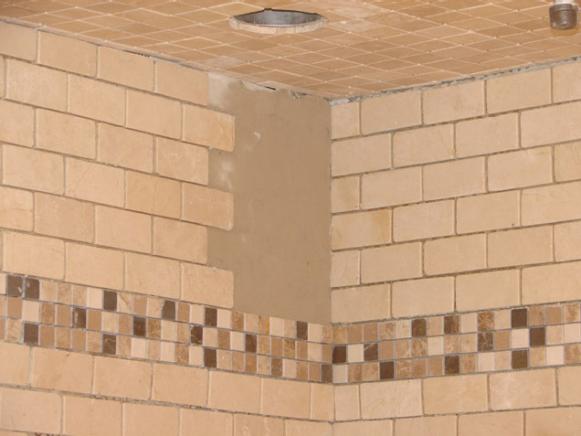
In our project, the back wall is a consistent 48.5" across and we used a decorative 3" mosaic border between the second and third panels from the top of the shower.
To get an accurate measurement, space out exactly how you will set the panels. After dry laying, determine the best place to start setting tiles working from the bottom up. In our project, several panels and the mosaic border is 84.5" tall. We started 72.5" from the top of the shower. Remaining bottom panels go last because cuts will need to be made.
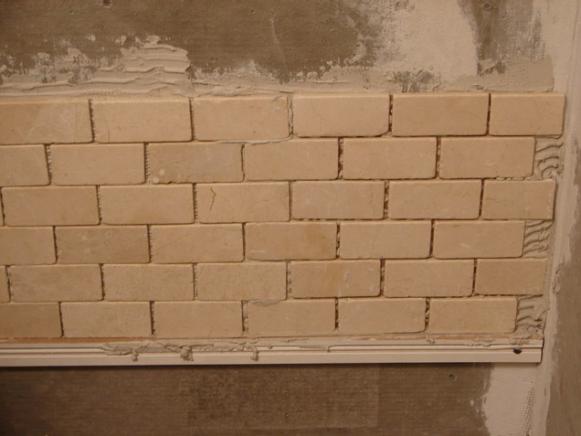
3. Use a starter board as a straight edge whenever you do a vertical tile installation to ensure panels go in straight and level.
Screw the starter board directly into the cement board and remove it after completing a series of panels. In our project, we installed the board on the shower wall at 72.5" from the top. Make sure the board is level before starting to set panels along this edge.
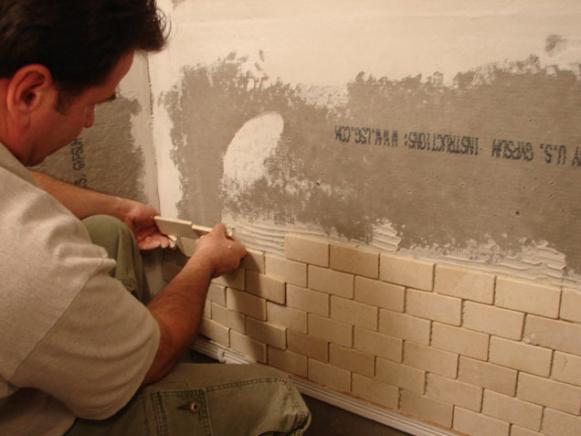
To prevent the tiles from sliding down after they're set, use non-sagging thinset mortar.
Use a notched trowel to spread the thinset which creates a suction to hold the stone in place as the mortar dries. Place the panel onto the thinset using the starter as a guide. Use a level to make sure tiles are straight. Once in place, push the tiles evenly into the thinset. Use your hands or a grout float to apply pressure.
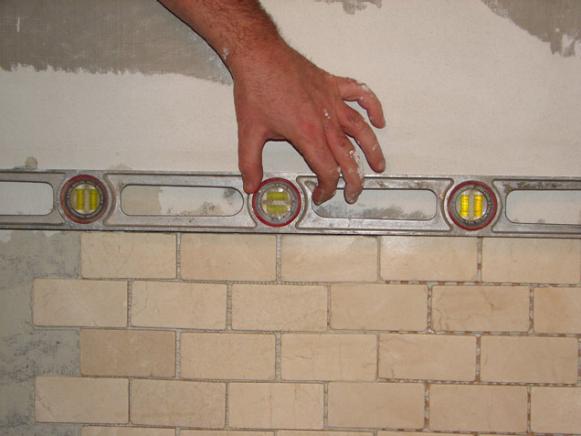
Wipe the tiles with water and a clean sponge as you set them. Check the level of each row before you set the next one.
Use spacers to hold tiles in place while they dry.
If a tile is broken, pull it off the cement board and replace it with one that is intact. Put the tile up in stages, a section at a time, so the thinset doesn't dry out.
4. Measure the width of the shower walls on either side of the door. Dry lay the panels and measure them to see where you need to make cuts. In our project, one wall is 31" and the other is 36".
Set the tile panels on the side walls with thinset, the same way as for the back wall, using the starter board. Clean the tiles with a sponge and water as you work. At the corner where there are gaps, fill in the spaces with cut tiles.
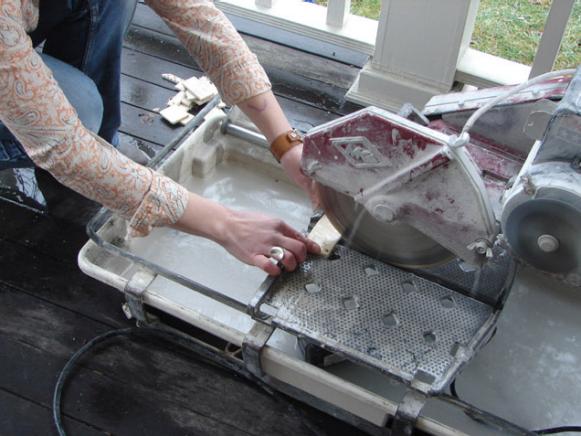
5. Once you finish setting the panels, make cuts for the edges of the walls. Use a wet saw to prevent tile from breaking or splitting.
Mark the tiles with a pencil where cuts are needed. Hold the piece firmly in place and gently slide it under the wet saw blade.
6. Cut pieces will have a straight edge that will clash with the tumbled marble look of the tiles when set against the exposed edge of the shower wall. Use a sanding stone to soften the edge, rendering a tumbled look.
Set these cut pieces individually along the edge using thinset, making sure the pieces lie up straight with the outside edge.
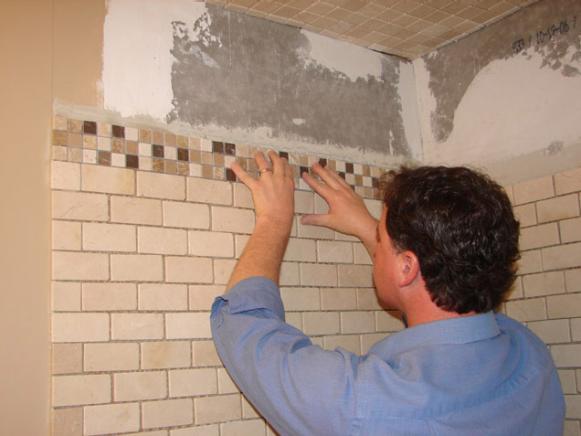
7. In our project, we set a decorative 3" mosaic border at the top of the shower walls between the second and third panel from the top. Because the border tiles are thicker than the other tiles, apply a thinner layer of thinset.
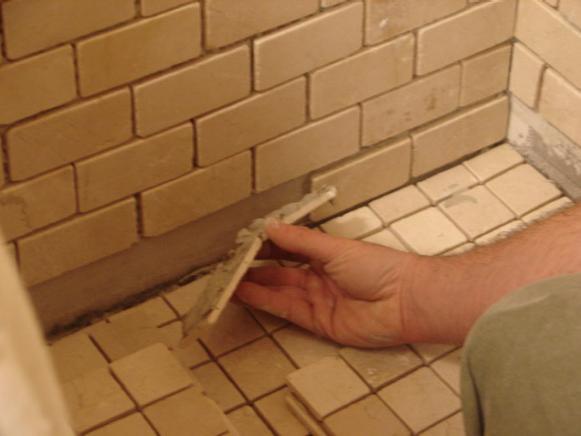
8. Finish setting the tiles on all sides of the shower with thinset.
If you find that you've applied too much thinset and it comes through the joints, take a screwdriver and scrape the excess thinset out. When the extra thinset dries, you will have a difficult time removing it and most likely it will not match the color of the grout.
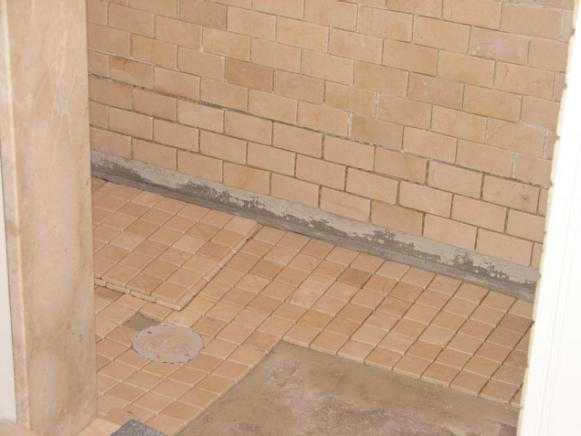
9. Next finish setting the shower floor with thinset. The shower floors are tiled with 2"x2" tiles.
Setting the floor tiles is the same as the walls: apply thinset on the floor, slide tiles into place and pat them down with the rubber grout float. If the floor has been poured perfectly, you don't have to worry about the pitch because all that work has been done already.
Important: Set the floor tiles last to avoid stepping on it while you tile the walls.
For the angled tiles around the drain, you will need to use a special tool to get the right shape. Mark the tile where you need to cut it. Use a tile nipper and chip away at the mark.
When you can't trowel the thinset directly on the surface, back butter the tiles individually with the notched trowel.
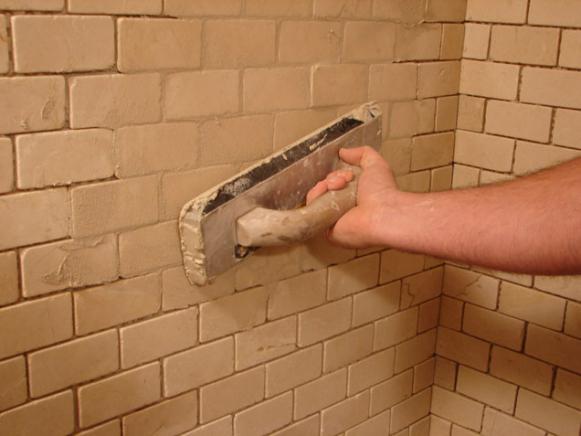
10. When the tile has set, mix the grout for the shower walls. Use a mix of 75 percent sanded grout and 25 percent non-sanded grout. Sanded grout is difficult to get into small joints so adding non-sanded grout helps thin it out so it can be applied more easily and aids application on walls.
Grout comes in many colors so use one that best matches your tiles. In our project, we used a cornsilk-colored grout, the same color used on the floor, in a thick oatmeal-like consistency.
Use a rubber float to apply the grout. Start at the bottom and work your way up, keeping the float at an angle to the joints.
Once all the joints in a section are filled, let it dry a little bit, then wipe the grout off the surface with a sponge and clean water.
Once the tiles have been cleaned up, allow them to set and dry.
Bathroom Tile Designs That Are Anything But Boring 20 Photos
From fair and simple to bold and intricate, these swoon-worthy tile designs will bring whole new life to your bathroom floors, showers and walls — or wherever you choose.

.-Battle-on-the-Beach-courtesy-of-HGTV.-.jpg.rend.hgtvcom.196.196.suffix/1714761529029.jpeg)




